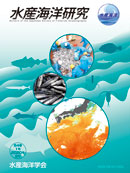
- Issue 4 Pages 261-
- Issue 3 Pages 149-
- Issue 2 Pages 61-
- Issue 1 Pages 1-
- |<
- <
- 1
- >
- >|
-
Nobuaki Nanjo, Yuki Funakoshi, Hiroyoshi Terakado2020Volume 84Issue 1 Pages 1-10
Published: February 25, 2020
Released on J-STAGE: March 17, 2022
JOURNAL FREE ACCESSBullet tuna Auxis rochei, which is primarily caught in the Pacific costal area of Japan, exceptionally is caught in large amounts in Toyama Prefecture, but the catches have decreased in recent years. It is difficult to investigate the cause of the decline in catches off Toyama, since studies of A. rochei in the Sea of Japan are scarce and fragmented. Thus, in this study, the biology of A. rochei in the Sea of Japan was investigated using samples caught off Toyama. Additionally, the migration pattern was also inferred from commercial catches from several prefectures along the Japan Sea coast. In Toyama Prefecture, A. rochei in the size classes of 30–35 cm FL were caught in summer, and then recruitment of the age 0 group with the mode of 22 cm FL occurred in autumn. Auxis rochei caught off Toyama Prefecture in summer were mature, suggesting that the coastal area of Toyama is one of the spawning areas of A. rochei in the Sea of Japan. Data of commercial catches in some prefectures showed both a northward migration in summer and a southward migration in autumn in the Sea of Japan. It seems that A. rochei migrate into Toyama Bay or from the Noto Peninsula to the southwestern Sea of Japan during the southward migration in autumn.
View full abstractDownload PDF (1207K) -
Shuichi Shiba, Takamune Himeno, Tsukasa Yoshida, Satoru Kamohara, Yosh ...2020Volume 84Issue 1 Pages 11-26
Published: February 25, 2020
Released on J-STAGE: March 17, 2022
JOURNAL FREE ACCESSTotal nitrogen, total phosphorus and chlorophyll a concentrations have decreased markedly, and water temperature has shown a tendency to rise in Ise Bay, central Japan in recent years. On the other hand, decrease of the standing stock of Manila clams (Ruditapes philippinarum) occurred suddenly in spring of 2014 at the Kosugaya tidal flat, one of the main fisheries areas on the eastern coast of Ise Bay, thereafter the decline of standing stock has continued. To clarify the relationship between environmental conditions and the standing stock of Manila clams, we added a term of the energy distribution to gonad to a conventional clam growth model that assumes water temperature and the quantity of phytoplankton as variables, and created a model that is capable of estimating growth and judging physiological death. Calculated growth of clams using time series data in 2014 suggested that the sudden decrease of standing stock in the Kosugaya tidal flat was likely due to physiological death caused by a drop in the quantity of phytoplankton. Moreover, based on the calculated growth of clams using the past trophic condition estimated from Aichi Prefecture environmental data, it is suggested that physiological death did not occur before 2008.
View full abstractDownload PDF (2394K) -
Mikimasa Joh, Taihei Matsuda, Keizo Yoshimura2020Volume 84Issue 1 Pages 27-35
Published: February 25, 2020
Released on J-STAGE: March 17, 2022
JOURNAL FREE ACCESSThe present study reared larvae and juveniles of barfin flounder Verasper moseri, observed otolith microstructure and validated daily formation of micro rings on sagittae and lapilli. For both otoliths, the check (distinct ring) was observed near the otolith core and the timing of check formation coincided with mouth opening. In lower water temperature, larval development became slower and the timing of check formation was delayed. Clear rings were formed outside the check, and the relationship between the age and the number of rings indicated that they were formed daily. After the onset of metamorphosis, secondary primordia were formed on the margin of sagittae. In contrast, there was no secondary primordium on lapilli throughout larval and juvenile phases. Thus, we suggest that lapilli are suitable for the otolith microstructure analysis throughout larval and juvenile life. The population of barfin flounder has been enhanced by the mass release of hatchery-produced juveniles that started in 2006. Recently, wild juveniles are found in the shallow water around Hokkaido. This study provides the key to clarifying unknown biology of field-caught juveniles.
View full abstractDownload PDF (1080K)
- |<
- <
- 1
- >
- >|